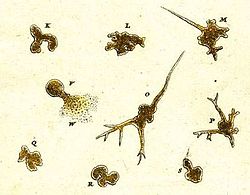Amoeba
Amoeba (plural = amoebae) is a well known genus of unicellular organism, a protist. One of its most common species, the Amoeba Proteus, is about 0.2 to 0.3 mm large. The amoeba was first discovered by August Von Rosenhof in 1757.[1] It is a genus of protozoa that moves with false feet, called pseudopodia.
The amoeba is a member of a whole group of amoeboid eukaryotic protists called Amoebozoa. They are heterotrophs, eating bacteria and other protists.
The pseudopodia (false feet) are extensions of the organism's cell membrane. They are used by the amoeba for phagocytosis (active food/nutrient intake) and motility (self-propelled movement).
Life
Amoebae are often found within freshwater, typically on vegetation in decay in still or slow moving water, or in the benthic zone (the flora and fauna found at the bottom of the sea or lake ) of some lakes. However, they are common organisms of study because it is easy to keep them in a laboratory. They are used to study sex protozoa and to demonstrate cell structure and function.
Amoeba Media
Clockwise from top right: Amoeba proteus, Actinophrys sol, Acanthamoeba sp., Nuclearia thermophila., Euglypha acanthophora, neutrophil ingesting bacteria.
The forms of pseudopodia, from left: polypodial and lobose; monopodial and lobose; filose; conical; reticulose; tapering actinopods; non-tapering actinopods
Amoeba phagocytosis of a bacterium
Foraminifera have reticulose (net-like) pseudopods, and many species are visible with the naked eye.
Trophozoites of the pathogenic Entamoeba histolytica with ingested red blood cells
Neutrophil (white blood cell) engulfing anthrax bacteria
Other websites
References
- ↑ Leidy, Joseph (1878). "Amoeba proteus". The American Naturalist. 12 (4): 235–238. doi:10.1086/272082. JSTOR 2463786. S2CID 222321758.
+{{{1}}}−{{{2}}}






